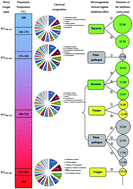Chemical constituents and antimicrobial activity of wood vinegars at different pyrolysis temperature ranges obtained from Eucommia ulmoides Olivers branches†
Abstract
Pyrolysis is a promising approach for converting biomass to solids, liquids, and gases. Herein wood vinegars (WVs) were produced from pyrolysis of Eucommia ulmoides Olivers (EUO) branches in different temperature ranges that were labeled as WV90∼120 and WV480∼510. The yield, the physicochemical characteristics, the chemical composition, and the antimicrobial activity of the WVs were comprehensively investigated. During the pyrolysis process, as the temperature increased, the yield of the WVs increased firstly and then decreased, and WV300∼330 achieved the maximum yield of 236.79 g, accounting for 23.26% of the total amount of raw WVs. However, both the lowest pH value (2.39) and the highest total acid content (12.70%) occurred for WV270∼300. GC-MS results demonstrated that six components of WVs for WV300∼330 were phenols, ketones, aldehydes, alcohols, organic acids, and benzenes, while no clear regularity between the contents of each component and the reaction temperature was found. Thereafter, the antimicrobial activity of WVs was tested, and the results showed that the longest inhibition circle diameter of 24.50 mm for Enterobacter aerogenes was obtained for WV300∼330 indicating an excellent antibacterial activity; the overall inhibitory effects of WVs on bacteria were superior to those of plant pathogens and fungus. Therefore, WV300∼330 showed a better antimicrobial activity than that of WV270∼300 in this study. The result could be a reference for the further utilization of WVs in the field of antimicrobial development.



 Please wait while we load your content...
Please wait while we load your content...